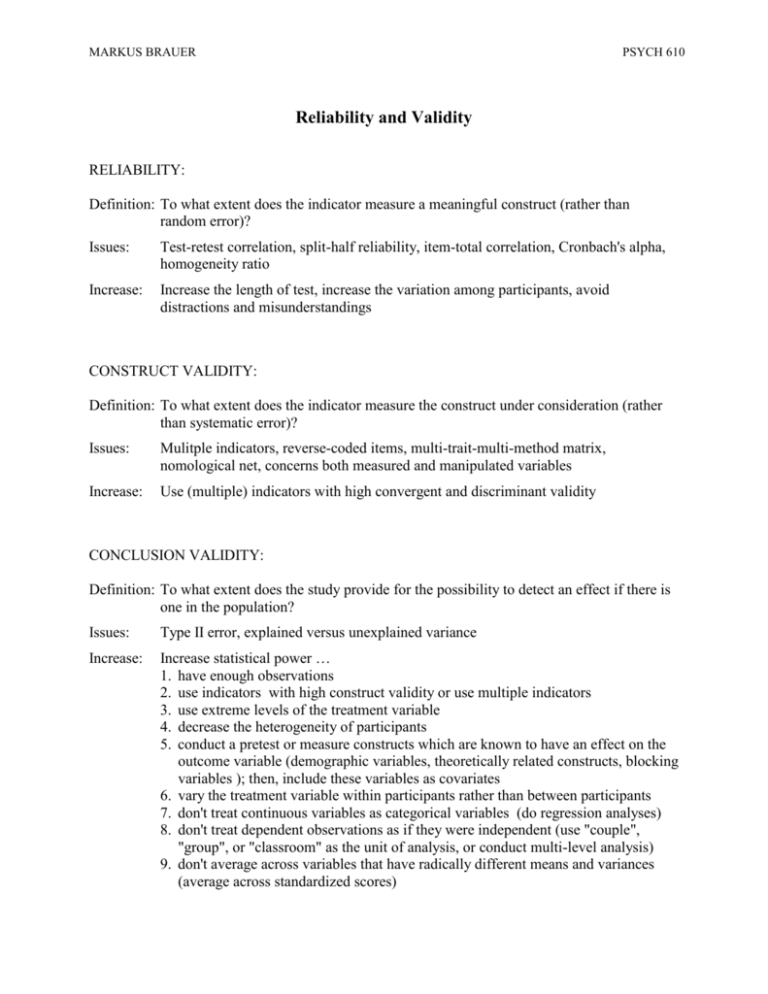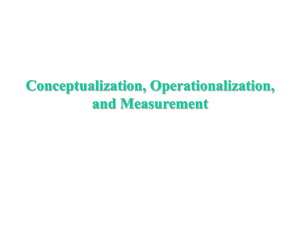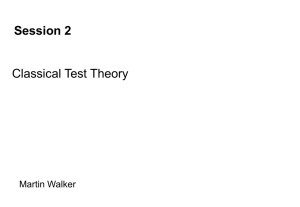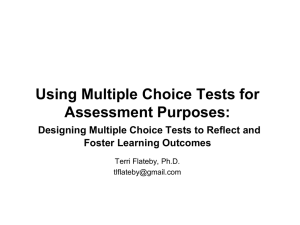Reliability and Validity
advertisement

MARKUS BRAUER PSYCH 610 Reliability and Validity RELIABILITY: Definition: To what extent does the indicator measure a meaningful construct (rather than random error)? Issues: Test-retest correlation, split-half reliability, item-total correlation, Cronbach's alpha, homogeneity ratio Increase: Increase the length of test, increase the variation among participants, avoid distractions and misunderstandings CONSTRUCT VALIDITY: Definition: To what extent does the indicator measure the construct under consideration (rather than systematic error)? Issues: Mulitple indicators, reverse-coded items, multi-trait-multi-method matrix, nomological net, concerns both measured and manipulated variables Increase: Use (multiple) indicators with high convergent and discriminant validity CONCLUSION VALIDITY: Definition: To what extent does the study provide for the possibility to detect an effect if there is one in the population? Issues: Type II error, explained versus unexplained variance Increase: Increase statistical power … 1. have enough observations 2. use indicators with high construct validity or use multiple indicators 3. use extreme levels of the treatment variable 4. decrease the heterogeneity of participants 5. conduct a pretest or measure constructs which are known to have an effect on the outcome variable (demographic variables, theoretically related constructs, blocking variables ); then, include these variables as covariates 6. vary the treatment variable within participants rather than between participants 7. don't treat continuous variables as categorical variables (do regression analyses) 8. don't treat dependent observations as if they were independent (use "couple", "group", or "classroom" as the unit of analysis, or conduct multi-level analysis) 9. don't average across variables that have radically different means and variances (average across standardized scores) MARKUS BRAUER PSYCH 610 10. transform skewed data and exclude outliers (especially when dealing with response latency data) INTERNAL VALIDITY: Definition: To what extent does the study allow us to draw conclusions about a causal effect between two or more constructs? Issues: Selection, maturation, history, mortality, testing, regression towrd the mean, selection by maturation, treatment by mortality, treatment by testing, measured treatment variables Increase: Eliminate the threats, above all do experimental manipulations, random assignment, and counterbalancing. EXTERNAL VALIDITY: Definition: To what extent can the results be generalized? Issues: Generalization concerns populations, treatments (causes), outcomes (effects), and settings. Increase: Random sampling, replication with different participants, different indicators, different stimuli, and in different settings Typology of Psychological Studies PLACE random in the laboratory in the field "laboratory experiment" "field experiment" "laboratory study" "field study" ASSIGNMENT RULE not random MARKUS BRAUER PSYCH 610











